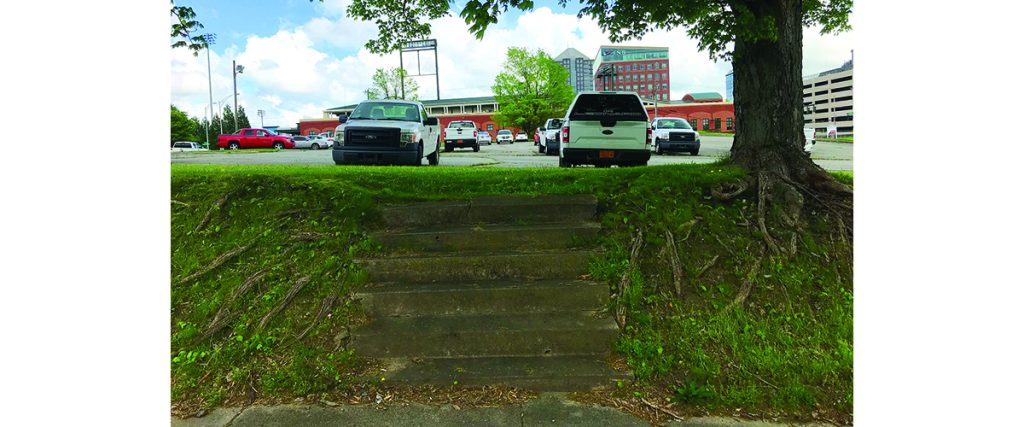Wandering Billy

On The Record
Any way you spin it, a documentary featuring Greensboro’s role in the Chitlin’ Circuit remains unfinished
By Billy Ingram
“Owning vinyl is like having a beautiful painting hanging in your living room. It’s something you can hold, pore over the lyrics and immerse yourself in the artwork.” – Steven Wilson
Just a short distance from the liquor store — er, the many exciting sights and attractions downtown Greensboro has to offer — is a set of concrete steps at 610 S. Spring Street, stubbornly clinging to relevance below a parking lot and a patch of grass destined for development.
In the ’50s and ’60s, this stairway to heavenly sounds led to what has been described as an inviting domicile fronted by two large maple trees, one of which still shades those steps. That’s where, during evenings and weekends off from his day job at the post office, longtime resident Edward Robbins began dabbling in music production and directing promotional television spots.
In the lo-fi world of the mid-’50s, this audiophile invested in the area’s only multitrack, high-fidelity Concertone stereophonic reel recorder when virtually every 45 and LP album in America was pressed in mono — and would be for years to come. Radio stations weren’t even equipped to play stereo discs in 1954 when Robbins Recording Studio was established in the back of his Spring Street home. The brand that touted “We Record Anything Worth Keeping” advertised not only futuristic technology, but also a grand piano and Hammond organ for backing tracks.
Robbins’ bread-and-butter was capturing church choir recitals and high school band performances, as well as recording local artists attempting to break into the music business. Just a few years later, 18-year-old Billy Crash Craddock laid down his first single, “Smacky-Mouth,” at Robbins’ for Greensboro’s Sky Castle label. Months later, the rockabilly crooner signed with Columbia Records. Also recorded there, the million-selling 45, “Radar Blues” by Coleman Wilson, released in 1960 on King Records.
A decade ago, Doug Klesch’s film project, Gate City Soul, got underway documenting the vibrant East Greensboro music scene with an emphasis on the Chitlin’ Circuit era. “I started realizing that there was this layer of stars and people that we hadn’t heard about,” Klesch tells me over coffee at the new Common Grounds downtown. “Nobody really seemed to have put it all together before.”
In the 1960s and 1970s, Robbins Recording Studio was only one of perhaps half a dozen or more recording studios and small-time record labels operating at any one time in Greensboro. “You go in, you pay your 40 bucks and you could record whatever you want,” Klesch says. Around 1960, Walt Copeland began recording and mastering out of his modest home at 4106 Peterson Avenue, relocating in 1964 to the WWll-era Overseas Replacement Depot district before becoming Crescent-City Sound Studios around 1969, located primarily at 1060 Gatewood Avenue.
“Robbins and Copeland were sort of the pioneers around here,” according to Klesch. “Crescent-City Sound, from what I’m told, was state of the art for that time, built on a floating floor. It wasn’t really as mom-and-pop as I would’ve imagined it to be in a market like Greensboro. These guys had a pretty nice little thing going.”
Greensboro R&B sensation and Carolina Beach Music Awards Hall-of-Famer Roy Roberts is one of the central characters in Klesch’s documentary. “Roberts is still alive and performing in his 80s,” he reports. “Bobby Williams — I think he’s still around — he had a band, Soul Central, that was playing a lot. George Bishop died shortly after I interviewed him in 2014.” In the 60s, Bishop corralled a bunch of A&T students working towards a music degree to form The Mighty Majors, who not only gigged around the East Greensboro scene and beyond, but also provided backup for big name touring acts. In the 1970s, Bishop owned a nightclub called The Command Post and later a record store, Mr. Entertainer, on Phillips Avenue.
Owned and engineered by David Lee Perkins, Tornado Records, located at 1712 Farrell Avenue, was one of the more prolific mid-1960s labels here, distributing primarily country and western, gospel, and bluegrass 45s by artists such as the South Mountain Boys, Dewey Ritter & the Panhandle Boys and The Caravans from Chicago. Although the label’s motto was “Another Tornado Hit,” their platters never really charted. Still, a handful have gained cult followings, like “Sensational New Discovery” by The Nomads, a psychedelic/garage rock combo out of Mt. Airy who released their second single, “Thoughts of a Madman,” through Tornado.
Walter Grady, a local impresario and independent music producer, launched several record labels throughout the 1970s, specializing in funk, soul and gospel recordings under the names Linco, Cobra, Graytom, Grayslak and Witch’s Brew. Produced by Slack Johnson, Electric Express recorded “It’s The Real Thing — Pt. I” at Crescent-City Sound for Linco. That instrumental track was quickly picked up by Atlantic Records’ subsidiary Cotillion for national and overseas distribution and spent four weeks on Billboard’s Top 100, peaking at No. 81 in August of 1971. “It was probably the biggest hit that came out of here as far as anything that went national. I want to say it was No. 13 or 14 on the Billboard R&B national chart,” Klesch says. He adds that the 1963 song, “Mockingbird, by Greensboro’s Inez and Charlie Fox, was, “probably the biggest national hit that wasn’t recorded here.” That tune was famously covered by Carly Simon and James Taylor 10 years later, reaching No. 5 on the Billboard pop singles chart.
Doug Klesch’s fascinating documentary remains incomplete but largely finished. Around 45 minutes of Gate City Soul can be found in three parts on YouTube. It’s the only comprehensive history of East Greensboro clubs and performers ever attempted, paused until someone can jump in to navigate the murky music rights legal maze. “I knew this from the beginning, but it became a reality the further I got into it,” Klesch says. “A lot of these recordings were bought up by companies whose business model is to sue anybody who samples them.”
Coincidentally, my buddy Jeremy Parker operates a recording studio out of his home where he lays down everything from punk to pop. It happens to be positioned just about a hundred feet from the steps that once led to Robbins Recording Studio, lo those many decades ago. A reminder that every generation has a potential to forge their own golden age.

In Passing . . .
I still haven’t fully come to grips with Natija Sierra Salem’s recent passing from complications due to a car accident that had occurred months earlier. Only 23 years old, tentatively blossoming into womanhood, she was one of those rare individuals who’d run up with a warm embrace whenever we bumped into each other, always thrilled to see me.
She was a tender ingénue with an arid sense of humor, eyes lit brightly, barely concealing a shadowy undertow. I say it often — and it’s true — the good die young, which speaks volumes as to why I’m still upright. There’ll never be another you, Salem. On that, everyone warmed by your smile can agree. I suppose one day life will begin to make sense, but it won’t be this day. OH
Billy Ingram’s new book about Greensboro, EYE on GSO, is available wherever books are sold or pulped.
